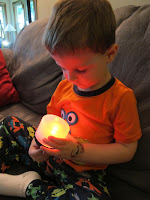Over the last couple months, our 2-year-old son Nathan has found his favorite new toys (and latest obsession) in the unlikely location of our Twins memorabilia shelf. He took a liking to our MN Twins Bobbleheads, although most of them aren't playing for the Twins anymore. We have Delmon Young, Joe Mauer, Torii Hunter, Joe Nathan, Brad Radke, Justin Morneau, and a small Ron Gardenhire figure that walks when you wind him up. We started lifting up Nathan to the height of the shelf and teaching him the names of each one, which he quickly picked up and could recite them in full to anyone who asked. Eventually we let him get them down and play with them. We like our bobbleheads, but we're no so attached to them that would deny our son the fun of playing with them.
Watching him play with the bobbleheads has been a constant source of entertainment and smiles. He brings them everywhere in the house. He'll stand them in a line in the laundry room, the bathroom, living room, kitchen, dad's workbench, and anywhere else he happens to be. He examines them with his doctor kit. He knows which ones are smiling, and he knows what each one is holding/doing (without looking). He sets them up on the dining room table so they can watch him eat his meals, and he lays them down for naps before he goes down for his own. It's ridiculously cute. To top it off, they seem to act as his conscience, and remember the rules of the house when he cannot. Lately his favorite is Delmon Young. Nathan tells us things like "Delmon Young says not to throw my fork on the floor" and "Delmon Young says don't bother the baby." Of course, you listen to him Nathan.
Knowing our son, we knew he would be careful with them (and he is), but accidents were bound to happen eventually. Joe Nathan's and Brad Radke's heads have come loose, which were easily fixed by re-gluing the spring to the head/body with some good epoxy. That was easy.
Then Delmon Young hit the tile floor. Twice.
The first injury was a decapitation at the base of the neck. While some glue might have held it, it was a spot that would be put under stress regularly and could easily break again. More drastic measures were required. This called for some bobblehead spinal fusion surgery.
Luckily the plastic was hard but wasn't too difficult to drill. I drilled a hole down into the torso and used epoxy to set in the shaft of a screw to act as reinforcement. Then I drilled a larger hole in the neck to give me some room for proper alignment, and filled the cavity with epoxy. Overall I'd say it came together fairly well and should hold strong.
About this time I was feeling pretty proud of my skills as bobblehead repair man and Dad. Delmon's body would sit on the workbench for awhile to let the epoxy properly cure. During this time Nathan was very concerned about Delmon and sad that he was missing from the lineup. We had to go down and check up on him regularly. He felt much better when we let him take care of Delmon's head while the body was under repair. Here's Nathan enjoying a morning snack with Delmon's head:
Sadly, tragedy struck the bobble-Delmon again before he could be put back together completely. Delmon's head fell off a table in the basement, hit the tile floor, and broke open.
This was when I learned the head itself was hollow, and rather thin in some spots. Nathan was devastated, and looked to me with "Daddy fix it" coming out of his mouth as it had so many times before. Challenge accepted.
Knowing how thin the head was, I wasn't comfortable leaving it empty. I wanted to reinforce it so it would hold up better going forward. I proceeded to superglue the big piece back on, and placed it in a small vise to hold it together while I filled the cavity with spray foam. I left the small pieces out so the foam could expand until it dried. This is how Delmon looked for at least a day:
This photo was taken on my workbench the night I started the cranial reconstruction. The next day Nathan wanted to go check on Delmon as soon as we got him out of his crib. He spent the rest of the day up on the mantle in the living room so Nathan could keep an eye on him. All day he would point up to Delmon's foam-extruding head and say things like "I just want to give Delmon a hug" or "when Delmon be all fixed, then I can play with him." Sure thing kiddo, I'll do whatever I can for you (and Delmon).
Tonight I cut away the excess foam, and trimmed back some of the plastic to get everything to fit. The fit wasn't as perfect as when it originally broke. Adding foam, glue, and epoxy kind of messed up the fit, but I think I got everything to come together fairly well. After my work tonight, here's how he looks now, happily bobbling away with his newly reinforced neck and head, ready to play some baseball. I made sure to get photographic evidence of him fully assembled and unbroken, as it may not last forever.
Tomorrow morning Delmon will rejoin his teammates (currently lined up on the Piano in our living room) for more adventures with our son around the house. I like projects & handyman challenges, and I love to make my kids happy. Thanks Nathan. Take care of the guys, I'd hate to see you have to lose one if he got damaged beyond repair.



































